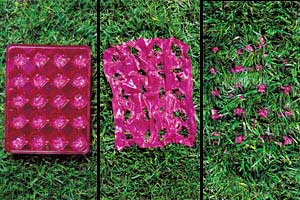| Trash that melts | 2002-06-28 00:07 5 comments |
 by Flemming Funch by Flemming FunchWired has a story about biodegradable plastic. Better than just biodegradable - it is made from corn starch, and when it has been used it will melt rapidly when exposed to moisture and microorganisms in soil, and it turns into carbon dioxide and water. Say Good-Bye to Plastic By Todd Woody It could be the biggest thing since sliced bread was wrapped in cellophane: biodegradable food packaging that's cheap enough to compete with conventional plastic. Once used, it can be thrown onto the compost heap or even eaten. This year, startup Plantic Technologies will roll out a cornstarch-based bioplastic that can be molded into everything from Twinkie wrappers to cracker trays. The technology, developed by the Australian government, could help usher in a 21st-century green revolution. Cornfields rather than oil fields could satisfy much of the enormous demand for plastic. A huge chunk of the 24 million tons of plastic that Americans toss each year would end up in backyard com-posters instead of landfills. And then there's the carnage that would be avoided if the plastic polluting the world's oceans dissolved rather than killing sea turtles, fur seals, and other wildlife. The road to ecologically safe, consumer-friendly bioplastic is littered with expensive failures and technological dead ends. But those problems are now being overcome, spurred in part by stringent recycling regulations in Japan and Europe. In 100,000 German households, for instance, chemical giant BASF is testing food bags and packaging made from its Ecoflex bioplastic, which contains a biodegradable petrochemical polymer. In the US, Biocorp North America is producing cornstarch-based biodegradable garbage bags, cups, and cutlery. The latest breakthrough has come in Australia, where scientists have developed an even better bioplastic: It biodegrades at temperatures as low as 33 degrees Fahrenheit - simply by being exposed to moisture and microorganisms in the soil. Your candy bar's bioplastic wrapper accidentally blows out of the car window as you barrel down the highway? Not a problem. With a little rain, it dissolves in an hour. In a matter of weeks, it disintegrates into carbon dioxide and water. Such technology appears to be unique, according to Steve Mojo, executive director of the Biodegradable Products Institute, a New York organization that analyzes compostable bioplastics. (It has yet to study Plantic's products.) Though Plantic closely guards the recipe for its patented polymer, it's happy to show off the result - a material with the look, feel, and flexibility of conventional plastic. It can be used for everything from cellophane and baggies to plant pots and medical devices. The company uses standard industrial extruders to produce cornstarch-based pellets, which are blown into sheets, then cut and molded into specific products. Food-packaging material costs about the same as petroleum-based plastic, approximately 32 cents per pound. The tougher versions of the material can withstand moisture for four to six weeks. Biodegradability does have its drawbacks. Get caught in a rainstorm with your groceries, and your cookie package could melt. And the more water-resistant, and thus longer-lasting, bioplastic is, the more expensive it is to make. Those costs must come down for Plantic to expand beyond the food-packaging market. "Dry goods packaging for chocolates and biscuits is just the first step," says David MacInnes, CEOof the year-old Melbourne company. "The main drive is to improve strength and reduce costs." Another challenge will be persuading multinational corporations, particularly American ones, to forsake longtime plastic suppliers for the Aussie upstarts. Why Oz? Chalk one up for government-funded research. A federal center developed the bioplastic and transferred the patent to Plantic. A scientific consulting firm took it from there, selling investors on the idea and hiring a management team. Already, several multinational food companies, including Cadbury Schweppes' Cadbury unit, are testing Plantic's bioplastic. Small purchase orders are in place for cookie and candy trays, which represent a $290 million global market. Plantic also has developed a bioplastic version of the agricultural film used by farmers as ground sheeting to grow tomatoes and other crops. Conventional sheeting - an $845 million global market - must be dug up after harvest, and some 650,000 tons of it end up in landfills worldwide each year. But with bioplastic film, farmers just pick their peppers, and the liner disappears harmlessly into the soil. Plantic will focus first on the European and Japanese markets, counting on multinational corporations' desire to make their reputations for polluting all but disappear. Wired News Photos: Chris Chen; Styling: Marcella Hayward/2C Management Disappearing act: Bioplastic packaging eventually breaks down into water and carbon dioxide (photos seen at 0 seconds (left), 30 seconds (center) and 1 hour elapsed time). |